Georgia Garden Year in Review

Fiscal Year 2025
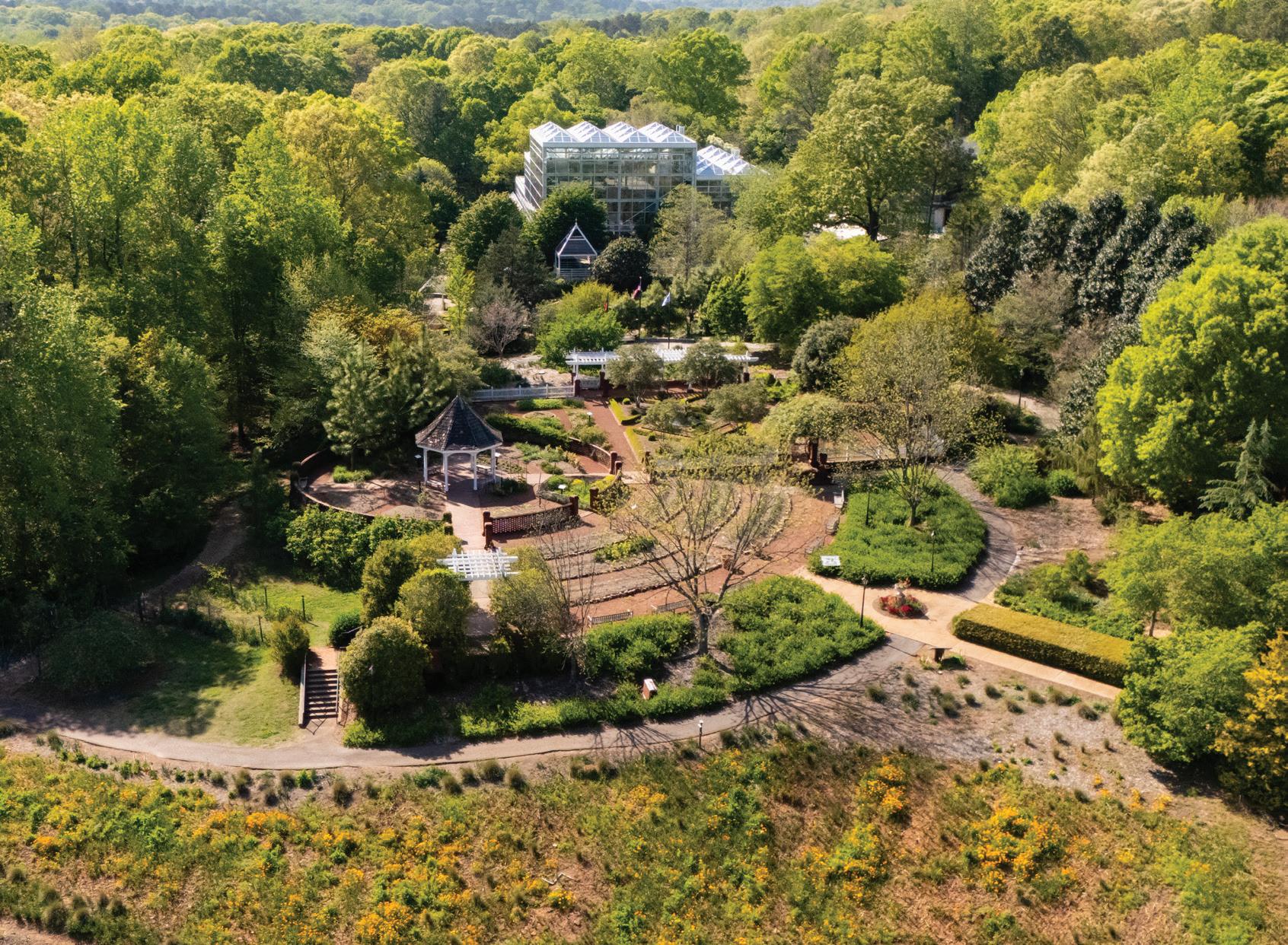


Fiscal Year 2025

465,000+ GARDEN VISITORS
The State Botanical Garden of Georgia, a unit of UGA Public Service and Outreach, is one of the state’s most treasured resources. With 323 acres of natural areas and cultivated gardens, the State Botanical Garden offers unique experiences for nature lovers.
The garden offers eight specialty gardens, including the Alice H. Richards Children’s Garden, and over seven miles of trails within an Audubon-designated important birding area. Throughout the year, the garden hosts educational programming, including camps, classes, workshops, concerts and festivals for visitors of all ages.
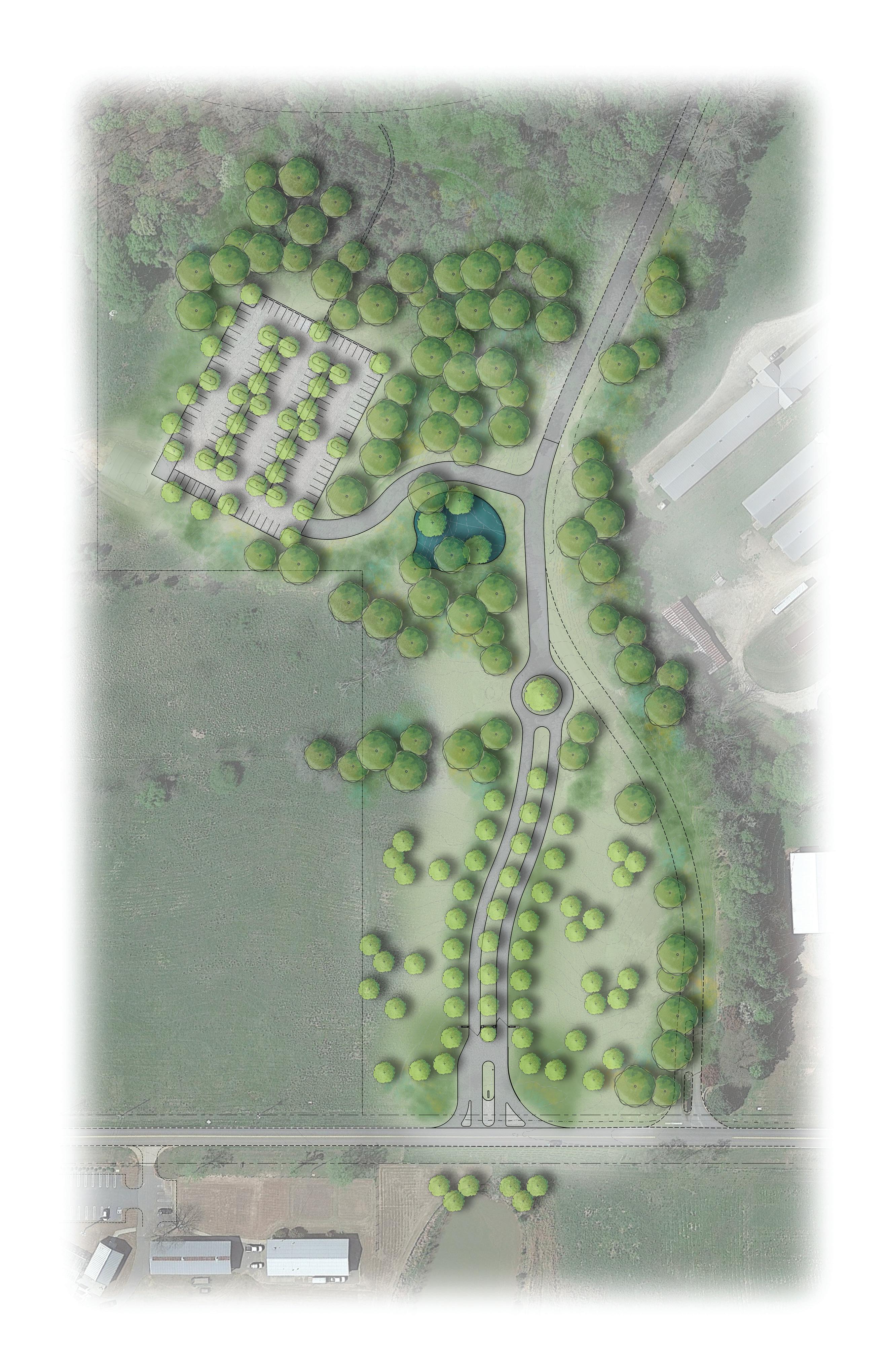
Facilities across the garden feature art exhibits and annual lectures, including the Porcelain and Decorative Arts Museum. The garden is also the headquarters for the Georgia Plant Conservation Alliance, a network of more than 100 institutions, agencies and organizations committed to ecological land management, native plant conservation, and protection of rare and endangered plants.
257 EDUCATIONAL PROGRAMS WITH 12,000+ YOUTH AND FAMILY PARTICIPANTS
65,000
WINTER WONDERLIGHTS VISITORS
350 VOLUNTEERS CONTRIBUTING OVER 15,000 HOURS OF SERVICE


This past fiscal year was an exciting time at the State Botanical Garden of Georgia. We celebrated several milestones this year, including the 40th annual Gardens of the World Ball, the premier fundraising event for the garden. We also celebrated the 30th anniversary of the Georgia Plant Conservation Alliance, a network of conservation professionals that has been hosted at the State Botanical Garden of Georgia for 30 years.
Attendance numbers have increased this past fiscal year, and we were thrilled to welcome over 465,000 visitors to experience the beauty of the garden and to participate in our impactful programs and events. The fourth year of Winter WonderLights brought 65,000 visitors to see the garden illuminated at night with 2 million lights. Proceeds from Winter WonderLights support our educational programs and critical conservation efforts to protect Georgia’s biodiversity.
We also welcomed several new staff members, including three new Georgia Native Seed Network Technicians. One of these positions is stationed here at the garden in Athens, with another stationed in Dry Branch, Georgia, at the National Seed Laboratory, and one technician working in partnership with the Jekyll Island Authority in Jekyll Island, Georgia. Having seed network staff
in locations throughout the state expands our capacity to collect native seeds for critical restoration projects in all of Georgia’s ecoregions.
Looking ahead to the next fiscal year, we are excited to continue progress on the Gateway to the Garden project. Phase one was completed in the spring of 2025, with the installation of rain gardens along the garden’s entryway to address infrastructure needs. We are incredibly grateful to The Office of the Provost at the University of Georgia for its support of this project. The second phase of the Gateway to the Garden project includes the construction of a new garden entrance on South Milledge Avenue. Updating and expanding the entranceway is essential to accommodate all who wish to benefit from the garden, its facilities and programs. We expect construction to begin in the spring of 2026, and we extend our deepest gratitude to everyone who has contributed to making this project possible.
Throughout this publication, you will learn more about what each of our garden departments have accomplished this year, and the impact they have on making the State Botanical Garden a free and accessible resource for our state. Thank you for your continued support of the garden.

Jennifer Cruse-Sanders, director

30
YEARS OF GEORGIA PLANT CONSERVATION ALLIANCE
403,000+ SEEDS COLLECTED
5
NEW STAFF MEMBERS FOR GEORGIA NATIVE SEED NETWORK
Georgia is the largest state east of the Mississippi River and is one of the most diverse states in terms of plant species, with nearly 4,000 found in the mountains, Piedmont and coastal plain. However, nearly 20% of Georgia’s botanical diversity is of conservation concern. With more than 800 rare plant taxa (species or subspecies) tracked by state conservation agencies, a recent assessment led by the Georgia Department of Natural Resources for the updated 2025 State Wildlife Action Plan identified 482 plant Species of Greatest Conservation Need.
The conservation team at the State Botanical Garden of Georgia works across the state to protect and conserve Georgia’s botanical resources. After receiving funding in 2024 to create the Georgia Native Seed Network, the garden now has five full-time staff members dedicated to collecting and propagating seeds from different ecoregions of Georgia for critical restoration projects. Two of these positions are based at locations other than the State Botanical Garden in Athens—one at the Native Seed Laboratory in Dry Branch, Georgia, and the other off the Georgia coast on Jekyll Island in partnership with the Jekyll Island Authority. The addition of these team members will significantly expand the garden’s ability to provide plant material for partners and commercial producers, thereby increasing the number of native plants in the Georgia landscape.
In addition to collecting and growing native plants, the garden’s conservation staff also engages in research. The garden’s conservation professional, Will Rogers, is developing genetic tools for federally endangered species Rhus michauxii, supported by the Georgia Department of Natural Resources’ Recovery Challenge Grant. The conservation team is looking forward to expanding the work of the Georgia Native Seed Network and continuing to make progress on safeguarding Georgia’s imperiled plant species this year.
- The State Botanical Garden of Georgia Conservation Team
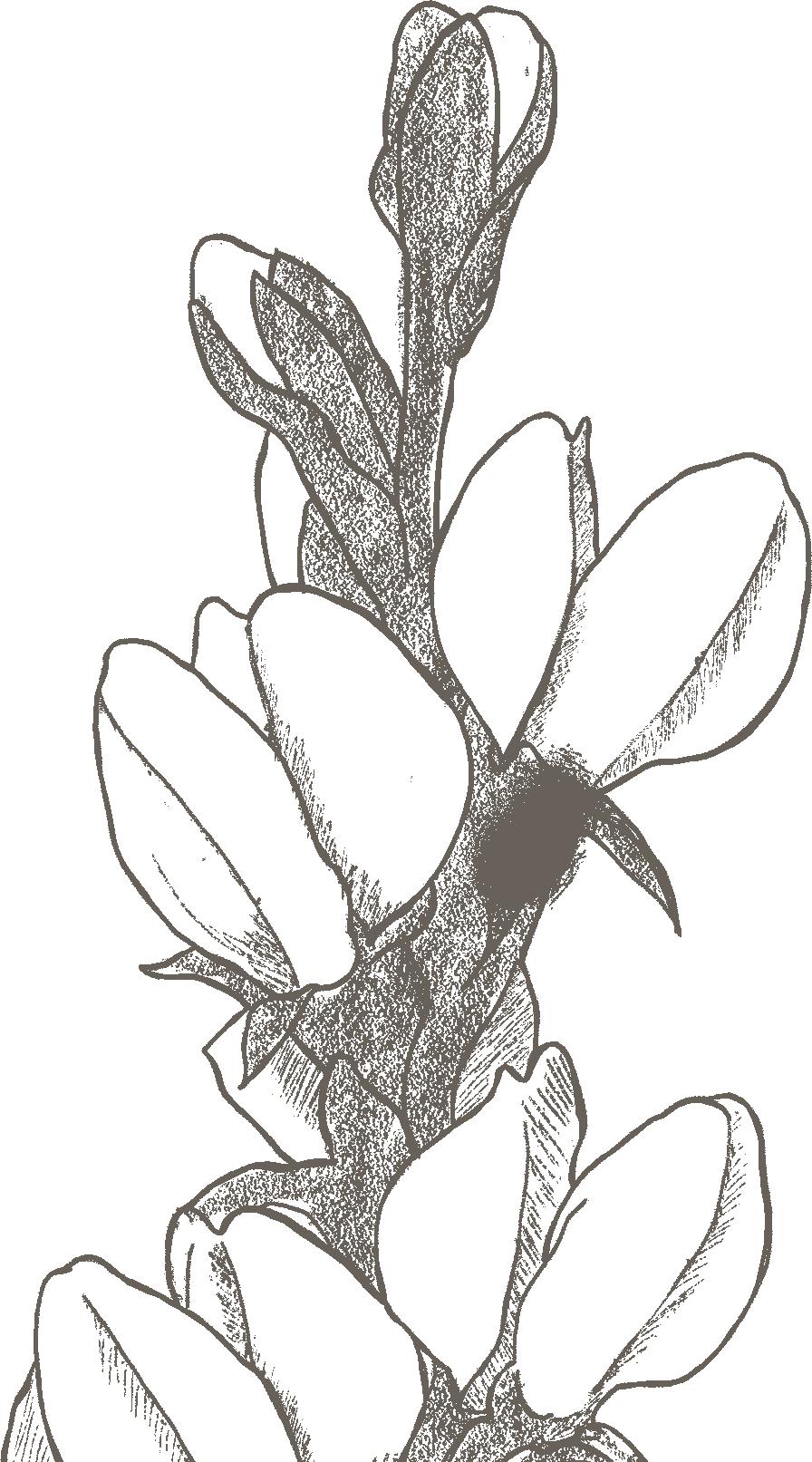
In 2024, the Mimsie Lanier Center for Native Plant Studies at the State Botanical Garden sourced, collected, propagated and sold over 10,900 native Georgia plants through plant sale events, contracts and the garden’s gift shop. These sales provided educational opportunities and native plant materials to over 2,400 people, helping them support pollinators, birds and other beneficial wildlife on their own land.
At the Mimsie Lanier Center, we installed crops of 15 selected species of Northeast Georgia ecotype plants for producing grassland restoration seeds. At Poteet Farm, a private family farm in Northwest Georgia, we planted crops of 10 species of Northwest Georgia ecotype plants to produce restoration seeds. These crops represent years of research and learning to identify top-performing plants in terms of growability, seed productivity, collectability and suitability for land restoration, focusing on ecosystem services and wildlife support.
The conservation team identified, curated, collected and produced local genotype plant material for restoration projects in Rabun, Murray and Whitfield counties, in support of the U.S. Fish and Wildlife Service. This plant material is crucial for restoring our state’s depleted environments and is not available elsewhere.
In 2024, we continued to maintain and track 22 living collections of sourceidentified rare Georgia plant species of known provenance, with greater than 10 individuals per collection. We also installed and inventoried a robust maternal line of seven distinct populations of the federally threatened smooth coneflower (Echinacea laevigata). Additionally, we collected, cleaned, counted and viability-tested thousands of federally endangered hairy rattleweed (Baptisia arachnifera) and began propagating them for future safeguarding collections at our garden and other partner gardens.
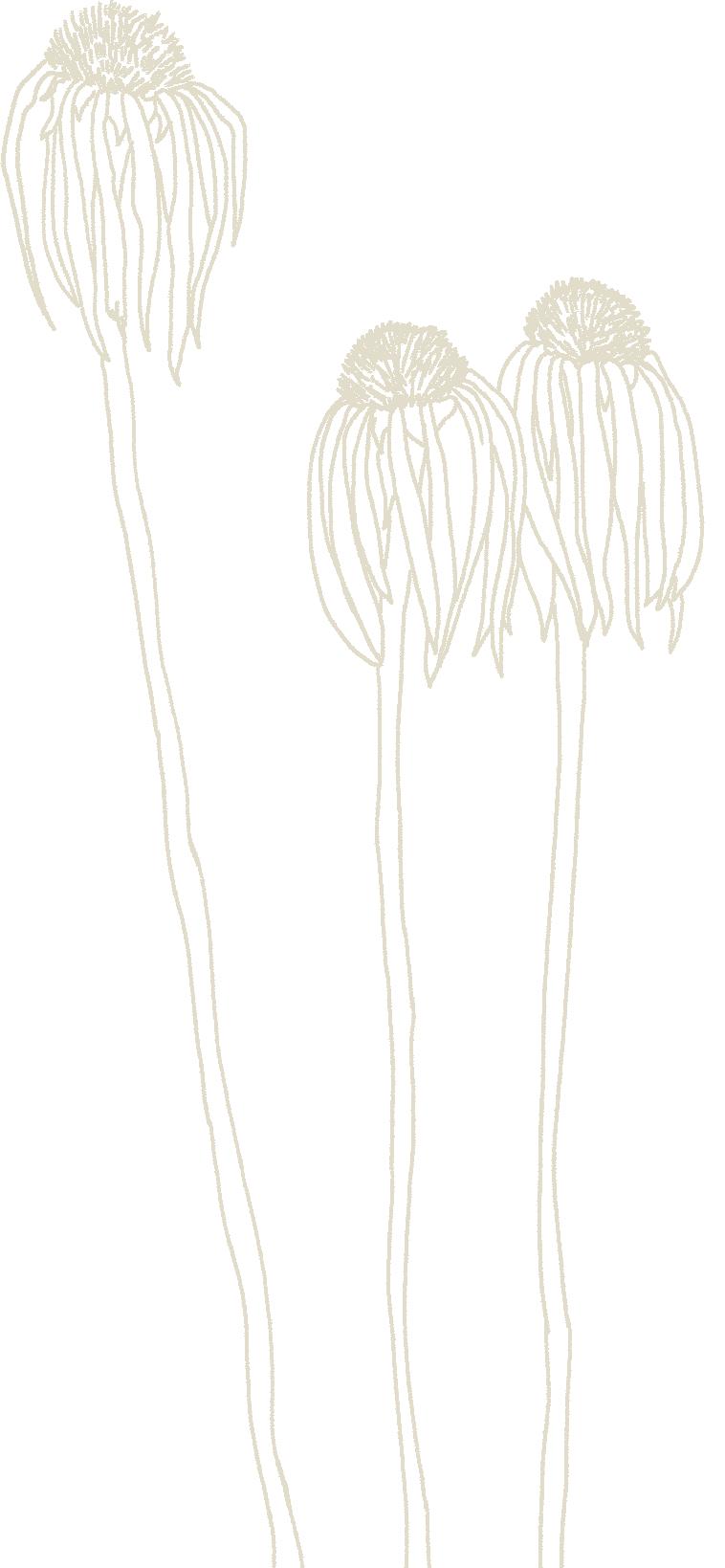
The Georgia Plant Conservation Alliance (GPCA) is a professional network that has been hosted at the State Botanical Garden of Georgia for 30 years.
In 2024, GPCA recovery actions, coordinated and facilitated by the State Botanical Garden, included 17 new collections of imperiled plant species made for safeguarding and living collections in Georgia. The GPCA also identified nine new locations of imperiled plant species that were previously undocumented.


By: Laurel Clark, communications manager
What started as a project by a University of Georgia graduate student in the 1990s, the Georgia Plant Conservation Alliance (GPCA) has flourished into a network of over 100 partner organizations working on the conservation of 111 imperiled plant species, as well as plant community projects.
Georgia is the largest state east of the Mississippi River and is one of the most diverse states in terms of plant species, with nearly 4,000 found in the mountains, Piedmont and coastal plain, according to the director of the State Botanical Garden of Georgia, Jenny CruseSanders.
However, nearly 20% of Georgia’s botanical diversity is of conservation concern. With more than 800 rare plant taxa (species or subspecies) tracked by state conservation agencies, a recent assessment led by the Georgia Department of Natural Resources for the updated 2025 State Wildlife Action Plan identified 482 plant Species of Greatest Conservation Need.
“As Georgians, we should care about these assessments because intact natural habitats
provide for food security, emergency preparedness and resilience to natural disasters, such as storms, hurricanes and wildfires,” said Cruse-Sanders. “Beyond the ecosystem value of plant species diversity, we know that thriving natural habitats provide daily benefits to us as humans. Documented health benefits for people who spend time in nature include decreases in blood pressure, heart rate, stress hormones, anxiety, depression, fatigue and inflammation.”
Recognizing the many reasons to preserve Georgia’s botanical heritage, GPCA has worked since 1995 to identify, prioritize and partner to achieve significant conservation successes for Georgia and beyond. GPCA has mentored and trained new conservationists who represent the next generation of experts, who are leading with innovative ideas to address future challenges.
GPCA, headquartered at the State Botanical Garden of Georgia, a unit of Public Service and Outreach at the University of Georgia, has also played a key role in launching state-based plant conservation networks in 15 other states.

While Jennifer Ceska, conservation coordinator at the State Botanical Garden of Georgia and the coordinator of the GPCA, was working on her master’s thesis at UGA, she had an idea to investigate how botanical gardens can support and promote conservation.
She consulted with colleagues in conservation programs across the U.S. to explore how this approach could be implemented and drew on that knowledge to develop guiding principles for the network, which was officially established in July 1995.
Founding partners for the alliance included representatives from the State Botanical Garden, Callaway Gardens, the Atlanta Botanical Garden, the Georgia Department of Natural Resources, the U.S. Forest Service and The Nature Conservancy.
The founding group decided that the state botanist would propose projects that they needed help with, and the alliance would share knowledge and resources to support these critical projects.
“It’s about showing up to make a recovery plan, growing plants and building trust. We call it
growing organically,” said Ceska. “There are no dues, it’s project-driven, and it’s meant to be simple so time and resources can go directly to the projects.”
The GPCA is an example of how partnerships are integral to achieving long-term goals. Since the network began over 30 years ago, no imperiled species have gone extinct on their watch. However, that does not mean it has been easy.
“We’re passionate about it, but it’s hard because you see the struggle of species in the wild. Every year, there are setbacks,” Ceska said.
One example of a GPCA success story is the recovery work on the Smooth Coneflower, Echinacea laevigata. When the GPCA began work with the Smooth Coneflower, there were only six significant populations left in Georgia, and all were in decline, according to Ceska.
The plants were struggling to exist on roadsides, and one of the largest populations was at risk of being poached. The State Botanical Garden’s Conservation Horticulturist Heather Alley has grown more than 2,500 plants, and GPCA has planted over 2,000 plants and sown 3,700 seeds directly into the wild. The six
natural populations are now stabilized through better management, and all have flowering plants and are producing seed.
In August 2022, the Smooth Coneflower was downlisted under the Endangered Species Act by the U.S. Fish and Wildlife Service from endangered to threatened, with the GPCA credited for its recovery work on this species in Georgia.
Another notable accomplishment of the alliance is its ability to prepare the next generation to tackle these issues. According to Ceska, there are well over 20 students and young professionals who have been mentored by the GPCA and are now successful plant conservation professionals.
Since the State Botanical Garden is located at the University of Georgia in Athens, Georgia, university students can connect with the garden and GPCA to gain hands-on experience and training, which translates to careers in plant conservation.
One of the network’s first interns was Cruse-Sanders, who previously served as the vice president for science and conservation at the Atlanta Botanical Garden before becoming the director of the State Botanical Garden of Georgia.


Lisa Kruse, senior botanist for the Georgia Department of Natural Resources, was also an intern at the State Botanical Garden and GPCA.
Carrie Radcliffe worked with GPCA as a graduate student and is now the co-director of the Southeastern Plant Conservation Alliance.
“Engaging with the Georgia Plant Conservation Alliance during my time at the University of Georgia allowed me to connect with professional botanists and land managers, as well as other researchers and students,” said Radcliffe. “Doing so enabled my participation in meaningful work that has had tangible outcomes for some of Georgia’s rarest plant species.
“Jennifer Ceska became my first female mentor when I was an undergraduate student. Since that time, I have watched GPCA grow into a strong community that has served as a model for other states. This success has inspired the work I currently do at the regional and national levels.”
Another success of the GPCA is the network’s ability to share its knowledge with other states that are looking to implement a similar plant conservation group. Ceska said GPCA has consulted with up to 15 states, including Alabama, Ohio, Indiana and Illinois.
The consultation GPCA provides is pretty simple, Ceska says, and much of the work involves encouraging other states that they can implement a similar program.

“The secret ingredient is asking how you can help,” Ceska said. “A group that is mission-driven is very successful, and the recovery of a rare species is a great mission to rally around.”
GPCA has been recognized with four national conservation and environmental excellence awards, including the 2013 Program Excellence Award from the American Public Gardens Association, the 2016 Special Recognition Award from the Association of Fish and Wildlife Agencies, the 2019 Honorable Mention Project Excellence Award from the National Association of Environmental Professionals and the 2019 Environmental Excellence Award from the Federal Highway Administration.
“In the over 30 years that I have been involved in the plant conservation world, whether as a student, a researcher, an advocate or a practitioner, I have never experienced a phenomenon quite like the GPCA,” said Mincy Moffett, a biologist with the U.S. Fish and Wildlife Service. “It is synonymous with plant conservation in Georgia. It is the umbrella organization for anyone interested in, or responsible for, plant conservation.
“GPCA leads and inspires and is the model that others seek to emulate both regionally and nationally. It has been the honor of my professional life to have linked arms with so many brilliant and dedicated plant conservationists, horticulturalists and land managers as we worked shoulder to shoulder to build this incredible organization.”
The best way to support the work of the Georgia Plant Conservation Alliance is by planting native plants in your landscape, Ceska said.
“Native plants on the land are essential,” said Ceska. “The wildlife that we love, including bees, butterflies, birds and box turtles, must have native plants to complete their lifecycle.”
GPCA also wants Georgians to value open space—landscapes with few trees or widely spaced trees where sunlight can reach the forest floor. More than 90% of imperiled native plant species in Georgia are sun-loving, clinging to rights-of-way, roadsides and park edges.
“There is a lot of pushback about letting open spaces go unmowed,” said Ceska. “People think that makes an area look unkempt or uncared for, but birds, bees and butterflies need the plant communities that survive in open spaces.
“This is something we want to teach Georgians, where it becomes regular in their lives.”
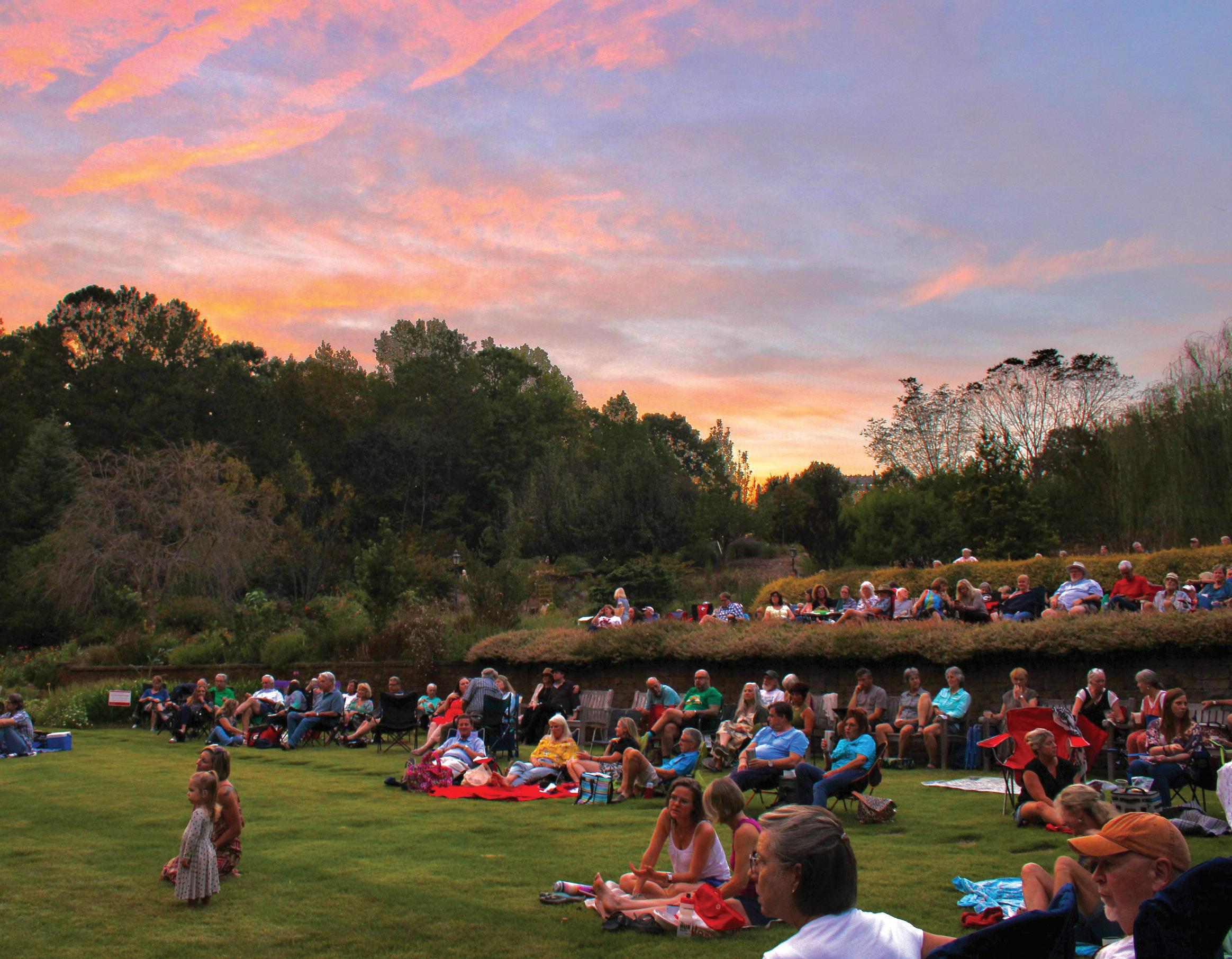
$2.5 million IN DONATIONS
2,950+ INDIVIDUALS, BUSINESSES AND FOUNDATIONS SUPPORTED THE GARDEN $435,000 IN GARDENS OF THE WORLD BALL SPONSORSHIPS $150,000 IN WINTER WONDERLIGHTS SPONSORSHIPS
The State Botanical Garden of Georgia relies on private funding to successfully underwrite operations, programming, facilities and educational outreach, and to keep the garden open free of charge to hundreds of thousands of visitors each year. In 2025, over 2,590 individuals, businesses and foundations supported our efforts with a total of $2.5 million in donations. These investments were made through various means, including capital campaigns, special events, annual fund appeals, estate and planned gifts, as well as memorial and tribute designations.
The garden’s current capital campaign, the Gateway to the Garden, finished FY2025 with more than $5.4 million received over the past three years to create an expanded and transformative new entrance. This project has garnered 27 major gifts, ranging from $25,000 to $250,000 each, a generous allocation of $2.35 million from the state of Georgia and includes proceeds from the last three Gardens of the World Ball events.
Special events, like the ball, contribute to the garden through sponsorships and ticket sales. This year’s Gardens of the World Ball secured $435,000 in sponsor support, while the ever-growing Winter WonderLights topped $150,000 in sponsorship underwriting. Rhythm and Blooms, an evening of music and local cuisine set within the magic of the Flower Garden lawn, contributed more than $35,000 to the garden’s conservation endowment, while the month-long celebration of Orchid Madness in February assisted the garden’s horticulture department.
The garden also asks its donor base each year for assistance in funding various priorities, such as our Excellence Fund and Education Endowment. These annual fund drives bring in hundreds of donations, ranging from $5 to several thousand, and are crucial in supplementing garden initiatives.
Estate and planned gifts are a crucial segment of our fundraising that ensures the future financial success of the garden. One 2025 gift, with a designation of half a million dollars, will create an endowment to support volunteer services in perpetuity. These directives are handled through the



garden in partnership with UGA’s Office of Gift and Estate Planning; please feel free to reach out to me directly to start a conversation about your possible legacy for the State Botanical Garden.
Finally, the garden is a wonderful place to commemorate a friend’s birthday, celebrate an anniversary or memorialize a loved one. Gifts range from $250 upwards and include choices such as a blooming bed of colorful flowers or a stately oak tree. New this year are UGAred Adirondack chairs, which will be found in restful spots across our cultivated spaces, and each is ready for a tribute plaque. Larger gifts, such as those to designate a forested hiking trail or to underwrite a faculty position, are additional options.
FY2025 was a dynamic year at the garden in many ways, and a banner year in regard to private giving. Thanks to each of you who have supported our endeavors, and to potential new donors for your consideration of support.
- Johnathon S. Barrett, Director of Development


Nancy and Glenn Black are two of the State Botanical Garden of Georgia’s staunchest supporters, giving generously with their time and personal resources.

Part of their generosity is evident in their support of the Gateway to the Garden campaign, as well as funding to refurbish a large section of the International Garden.
Their immense generosity will also extend into perpetuity from a planned gift. Through their estate, the Nancy and Glenn Black Volunteers Services Endowment will be created. This fund is intended to provide underwriting for the ongoing costs associated with maintaining a solid and successful volunteer program at the garden. Volunteers are key to ensuring the garden remains free and open to the public year-round.
Other meaningful gifts in 2025 included a sponsorship of Winter WonderLights, as well as very thoughtful memorials given in remembrance of two dear friends who have passed away.
The State Botanical Garden of Georgia is grateful for this amazing and incredibly benevolent couple and all they do to ensure the prosperity of its extensive efforts.
Nancy has lent her talents to the garden since 2002 and serves on the board of directors of the Friends of the Garden. Her bright and gracious smile greets visitors each Tuesday in the garden conservatory. She recently said, “The garden is a place of beauty and inspiration, and giving back feels like planting seeds of hope for tomorrow. And that’s a seed that once sown never dies.”
Glenn, a UGA alumnus, shares Nancy’s passion for the state’s botanical treasure. Together, the couple, who have been married for 54 years, made three major gifts to the garden this past year.
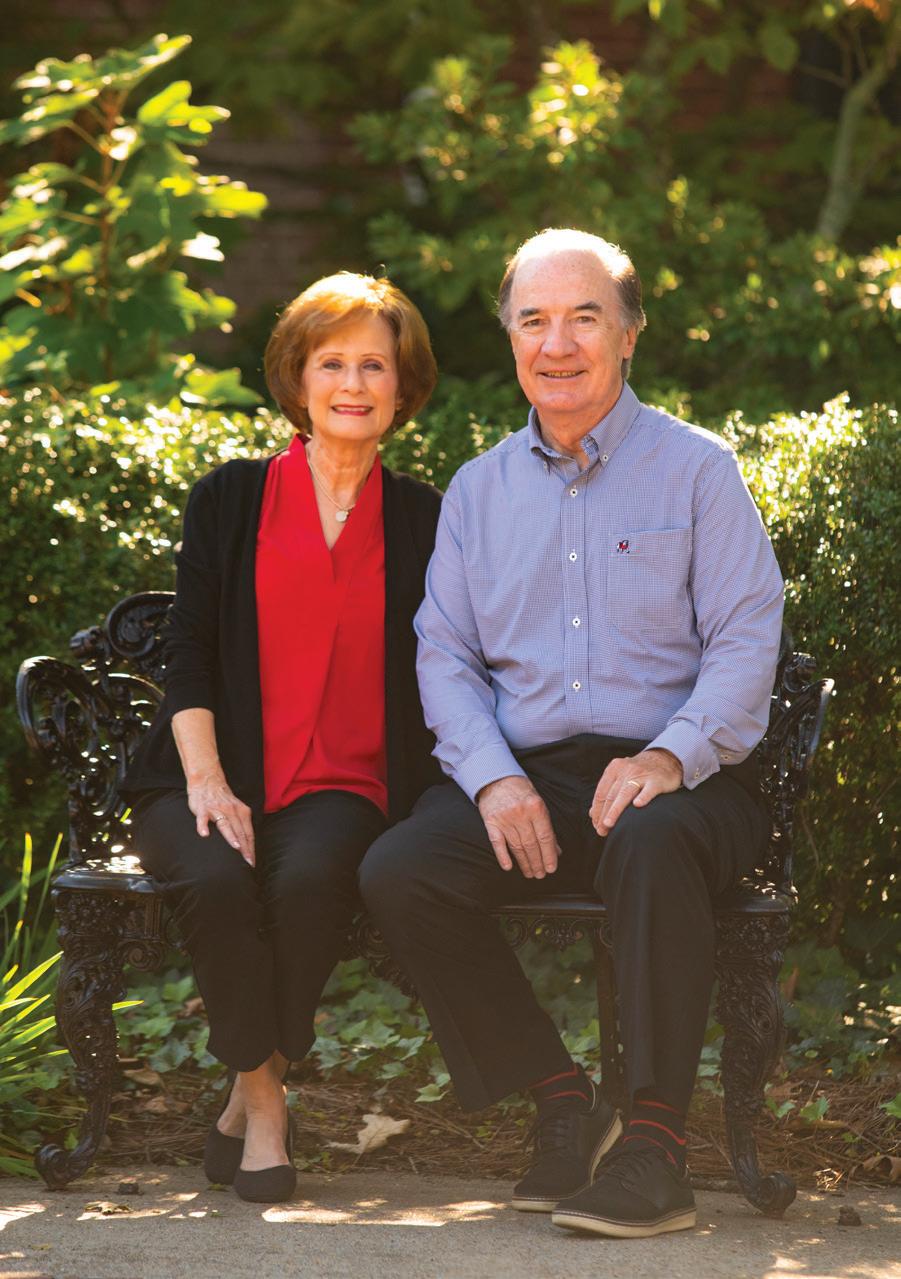

Ed and Lilli Grenvicz had been married for more than 50 years when Lilli passed away unexpectedly. Ed was determined to keep her memory alive and wanted future generations to know of her love for gardening, art and animals. He approached the State Botanical Garden of Georgia to help with those loving wishes, and three rich legacies were created.
The first was a major gift designation through a planned gift. In time, Ed’s estate will endow, in perpetuity, the Lilli Grenvicz Director of Horticulture and Grounds at the State Botanical Garden of Georgia, a faculty position. With Lilli’s devotion to botanicals, Ed felt it was fitting to lend Lilli’s name to such a crucial area of impact at the garden.
“Lilli loved all things beautiful and was an ardent gardener. The professorship is something that will go on later in life and continue to serve her memory in a very special way,” Ed said.
Ed then went a step further and decided that he wanted something substantive to commemorate Lilli that would have an immediate impact on the garden. First, he gave a major gift to restore a section of the Flower Garden, which, like Lilli’s floral style, features an informal, eclectic design and even showcases a hydrangea, her favorite. There is a plaque there celebrating Lilli’s life.


Next, he approached the garden with another offer of generosity—one that would give even more recognition to his late wife, and provide additional assurance for the garden’s financial future. This third investment, and Lilli’s legacy, is now acknowledged in the Plaza Front Garden.
The State Botanical Garden is grateful for Ed’s magnanimity and is also extremely honored to be chosen to recognize and remember the life of Lilli Grenvicz in such meaningful, heartfelt ways.

By: Laurel Clark, communications manager
The State Botanical Garden at the University of Georgia recently completed infrastructure improvements to its driveway. This is the first step in a series of improvements planned for the garden over the next several years, called the Gateway to the Garden project.
The Gateway to the Garden project will include an updated entranceway, improved trail access and additional parking to accommodate the increasing number of visitors the State Botanical Garden welcomes annually. The Office of the Provost at the University of Georgia funded the project’s first phase to address infrastructure needs along the garden’s driveway.
“We are thrilled to begin work on the Gateway to the Garden project that will help us welcome more visitors to the garden and support our mission to create an environment for learning, inspiration and engagement in an accessible way,” said the garden’s director, Jenny Cruse-Sanders. “We are extremely grateful to the Office of the Provost for the support to begin the project.”
The engineering of rain gardens and the resculpting of the land along the driveway will help manage stormwater runoff. The rain gardens include native plants that filter, clean and absorb water, providing an example of green infrastructure. The garden’s horticulture staff collected seeds from the garden’s property and grew the plants for the project in the garden’s greenhouse.
“This is why native plants are essential,” said the garden’s director of horticulture and grounds, Jason Young. “We’re mimicking existing habitats along our entrance road with plants known to survive these conditions. The beauty of native plants is that they’re suited to our conditions, and they’re resilient.”
The green infrastructure improvements to the garden’s driveway can serve as a model for visitors to implement similar practices in their home gardens. It is also an example of sustainable roadside maintenance, which the garden’s conservation team is working with statewide partners to implement.
In 2021, the State Botanical Garden of Georgia partnered with GDOT and Keep Athens-Clarke County Beautiful to plant native species along the entrance ramp next to the GA-10 Loop at Milledge Avenue.
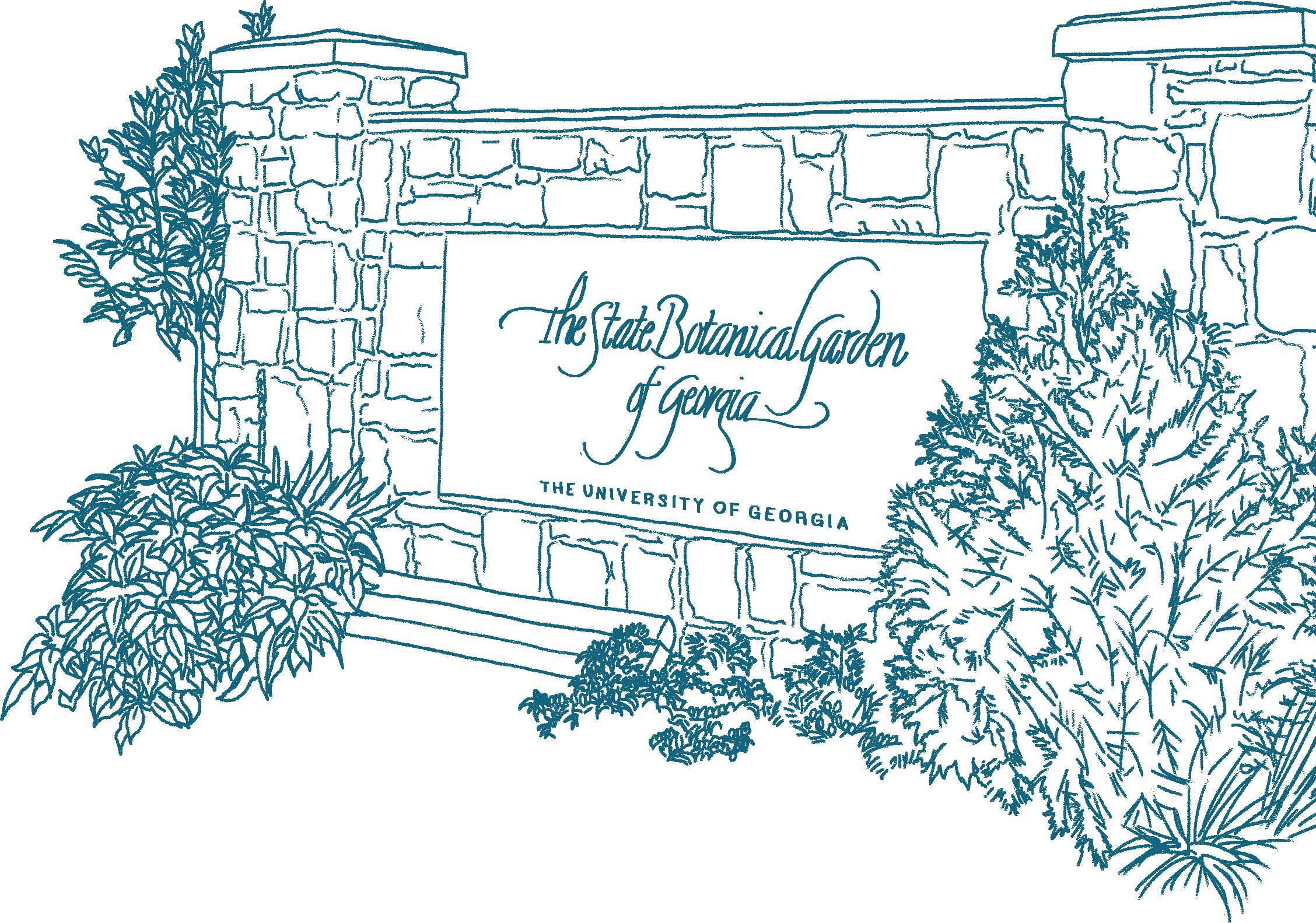
“Native plants function to support their ecosystem, and that’s important because our roadsides are turning into monocultures of non-native species that don’t support our native wildlife,” said Zach Wood, the garden’s Georgia Native Seed Network manager.
He added that non-native species don’t filter water as well as native species, which is significant for handling stormwater runoff on roadsides.
The State Botanical Garden of Georgia encourages people to plant native and pollinator-supporting species through its Connect to Protect and Georgia Pollinator Plants of the Year programs. The garden also hosts a spring plant sale in April and a native plant sale in October, which allows community members to talk with experts who can help them make excellent selections for their home gardens.


The education department at the State Botanical Garden of Georgia continues to bring our mission to life—nurturing environmental stewards of all ages through lifelong learning. From preschoolers to retirees, we believe in the power of connecting people to nature and to one another through hands-on, meaningful experiences.
PARTICIPANTS IN EDUCATIONAL PROGRAMMING WITH
830 HOURS OF INSTRUCTION
12,000 4,200
51 LEARNING BY LEADING™ STUDENTS CONTRIBUTING NEARLY HOURS
842 POUNDS OF PRODUCE HARVESTED FROM THE CHILDREN’S GARDEN
Our programs span all ages and interests: the Sweet Pea Club introduces our youngest learners to the wonders of the natural world; field trips, camps and family festivals ignite curiosity in youth; Learning by Leading™ empowers university students through real-world leadership experiences; and our adult offerings—from Nature Ramblers to our Certificate in Native Plants and symposia— provide in-depth opportunities for seasoned learners.
One standout initiative this year is our Certificate in Sustainable Landscape Design. Taught by Dr. Richard Ludwig—former host of PBS’s “GardenSmart” and former Southern Living garden specialist—this program explores practical and ecological approaches to landscape design, from theory to hands-on applications. It’s another example of how we equip learners to make sustainable choices in their own backyards.
This work would not be possible without the many hands that help it flourish. We are deeply grateful for our part-time educators, Learning by Leading™ team members and dedicated volunteers. Our collaborations with university departments, environmental education centers and statewide partners allow us to continue delivering relevant, engaging and accessible programming that connects our community to the natural world.
As we look ahead, we remain committed to fostering curiosity, stewardship and joy in nature—one learner at a time.
- Cora Keber, Director of Education
In partnership with the UGA Cognitive Aging Research and Education Center (CARE), the State Botanical Garden of Georgia launched Meet Me at the Garden—a program designed for people living with dementia and their care partners to connect through gardening, nature and shared experiences. The goal of this program is to create a feeling of excitement, curiosity and education about everyday familiar items.
The pilot program began in spring 2023 and each session invited participants to explore garden-related topics, participate in sensory walks and engage in hands-on, themed activities—from making herbal tea bags and tasting chocolate to creating seasonal crafts and harvesting fresh produce.
With CARE Center scientists, we designed pre- and postsession measures to gather meaningful data from care partners. This ongoing research aims to expand access to inclusive garden experiences across the state, tailored to meet the unique needs of people living with memory loss.

Together, with our partners, we are building a model for compassionate, enriching and research-driven engagement that helps individuals and caregivers thrive—planting seeds of connection that we hope will grow statewide.
While summer camp is undeniably fun, its design goes far beyond games and childcare. Since its inception in 2001, our camp has evolved into a robust program offering seven weeks of full-day camps and a half-week of half-day programming. Since 2014, we’ve introduced themed weeks such as Georgia Critters, Water World, Nature Rangers, Woodland Warriors and Bee Smart Eat Smart, offering campers immersive experiences in nature through hikes, crafts and exploration.
Our programming spans all age groups: Sweet Pea Camp welcomes our youngest learners (ages 3–4), themed camps engage children ages 5–10, and our Environmental Sciences Camp challenges youth ages 11–14. Many campers return year after year, growing through each stage of the program.
To continue this journey, teens can join our Junior Counselor program, volunteering alongside staff to lead games and mentor younger campers. Each summer, we see former campers return as Junior Counselors—and some even come back as college students to serve as camp counselors. This full-circle experience reflects the lasting impact of our camp, with many participants sharing how their time here shaped their memories, interests and future aspirations.


The Friends of the Garden supported the State Botanical Garden in many ways this past year. The Sunflower Concert Series, Winter WonderLights and Orchid Madness are just a few examples of events the Friends sponsored. Additionally, many of our Friends volunteer their time, which is crucial for the State Botanical Garden to remain a free and accessible resource for its thousands of annual visitors.
The Sunflower Concert Series presented a diverse selection of musical artists to the garden, including the Randall Bramblett Band, the New Orleans Jazz Stompers, the Original Splitz Band and Abbey Road Live. A now-established Athens holiday tradition, the Friends were happy to help support a very successful Winter WonderLights production this past winter. The spring opened with Orchid Madness, which included Botanic Musicale, Sip & Paint, Orchids and Chocolates, the Johnstone Lecture and an Orchid Repotting Class.
Each month of the year, we hosted a Friends First Friday event that varied in subject matter, bringing together Friends and community members. Just a few of the topics covered include the Founders Memorial Garden at UGA, garden snakes, container gardening and monarch butterflies. We are excited for the lineup of speakers we have for this year’s Friends First Fridays, and hope to see everyone there!
- Jessie Penouilh, Friends Membership Coordinator
53
1,400+ YEARS SUPPORTING THE GARDEN
FRIENDS MEMBERSHIPS SUPPORTING THE GARDEN
540+
ATTENDED FRIENDS FIRST FRIDAY EVENTS
President
Karen Radde
Vice President
Pamela Bracken
Secretary
Kay Petroff
Treasurer
Dennis Calbos
Immediate Past President
Eileen Hale
Endowment Trustees
Mercer Brockenbrough
James L. LaBoon III
John V. Quackenbush
Ellen Wilkens Wiley
Members at Large
Shirley Berry
Nancy Black
Ann Davis
Betsy Ellison
Juli Fields
Celia Fowler
Susie Haggard
Taylor Jenkins
Shelly Prescott
John V. Quackenbush
Anne Walker
William A. “Bill” Walker
Tootsie Adams, Athens
Betsy Barge, Marietta
Lisa Bell, Savannah
Malinda Bergen, Savannah
Mary Bishop, Sea Island
Sherri Callaway, Hamilton
Natalie Schweers Coghill, Augusta
Jeff Cole, Athens
Geri Coleman, Atlanta
Amy Cowsert, Athens
Andrew Crawford, Atlanta
Christopher Davidson, Gainesville
Martha Deméré, Sea Island
Betty DeVore, Athens
Evelyn Dukes, Athens
Cindy Edwards, Savannah
Betsy Ellison, Athens
Susan Braselton Fant, Sea Island
James Farmer, Perry
Melissa Fontaine, Athens
Ann Frierson, Athens
Kelly Grow, Athens
Robert Hallock, Savannah
Catherine Hardman, Athens
Mary Hardman, Athens
Francie Hargrove, Cashiers, NC
Paula Hennessy, Atlanta
Maudie Huff, Columbus
Karen Hull, Augusta
JP James, Brookhaven
Truett Jarrard, Atlanta
Jimmy Jeter, Moultrie
Sally Jobe, Atlanta
Dori Jones, Columbus
Sally Jones, Sea Island
Gena Knox, Athens
Merry Jo Kurrie, Valdosta
Betsy Leebern, Columbus
Carrie Lovein, Atlanta
Brenda Magill, Athens
Polly Mattox, LaGrange
Marianne McConnel, Atlanta
Tavia McCuean, Atlanta
Jim Miller, Atlanta
Farolyn Mobley, Moultrie
Caroline Morris, Augusta
Alannah O’Quinn, St. Simons Island
Sandra Paris, Atlanta
Alex Patterson, Gainesville
Hart Payne, Gainesville
Doreen Poitevint, Bainbridge
Kathy Rainer, Atlanta
Loulie Reese, Atlanta
Georgia Schley Ritchie, Atlanta
Victoria Simms, Sea Island
Henrietta Singletary, Albany
Lacy Sinkwich, Athens
Janie Skinner, Atlanta
Eileen Small, Atlanta
Haynes Studstill, Lakeland
Nancy Thomas, Screven
Elizabeth Townley, Bogart
Sally Tyndall, Atlanta
Ruth Wellborn, Greensboro
Joel Wernick, Greensboro
Tom Wight, Macon
Cynthia Willett, Bluffton, SC
EMERITUS MEMBERS
Betty Balentine, Atlanta
Diana Barrow, Savannah
Dottie Blitch, Atlanta
Mark Callaway, Atlanta
Pat Carlock, Atlanta
Linda Cravey, Atlanta
Susan Duncan, Highlands, NC
Jim Gatewood, Americus
Sylvia Gibson, Athens
Lynwood Hall, Moultrie
Georgia Hatcher, Macon
Mimsie Lanier, Sea Island
Peggy Lientz, Atlanta
Alden Maier, Rome*
Cindy Moore, Savannah
Felton Norwood, Atlanta
Colleen Nunn, Atlanta
Penny Nunnally, Atlanta
Stephen Reichert, Macon
Margaret Robinson, Sea Island
Deen Day Sanders, Norcross
Betty Sponcler, Dalton
Nancy Tarbutton, Sandersville
Robert Winthrop, Athens
Kathy Young, Marietta
LIFETIME MEMBERS
Cyndae Arrendale, Atlanta
Melba Hill, Atlanta
Kathy Lanigan, Thomasville
Marilyn McNeely, Clarkesville
Mark Preisinger, Sea Island
Hart Roberts, Athens
Sissy Lawson, Gainesville
Ken Hodges, Albany *deceased
As the incoming chair of the Board of Advisors of the State Botanical Garden of Georgia, I want to express my gratitude and thanks to all who made our FY2025 a success. As you will see outlined herein, exciting progress was made on numerous fronts at the garden. This progress required the commitment and dedication of many individuals. We are especially blessed with a wonderful staff that continues to amaze and delight with vision and dedication to improvement.
I especially want to thank Tom Wight, our outgoing chair, for his commitment to continuing the progress on our entrance project and the endowment for the Porcelain and Decorative Arts Museum. Of course, we would not be the same special place to visit without the Friends of the Garden. Many thanks and accolades to these members who give of their time and talent to beautify the garden experience for all of us.
As we look to the promise of FY2026, we have a great opportunity to build on our momentum and strategically chart the course for years to come. We anticipate celebrating a new entrance, refreshed portions of the garden, and an updated long-term plan by the time we close out the fiscal year. And in between, we’ll enjoy each other’s company across the state as our board gathers in Atlanta, Athens and Columbus.
There’s so much promise ahead. I hope to see you soon at the garden.
- Natalie Schweers Coghill, Chair of the Board of Advisors
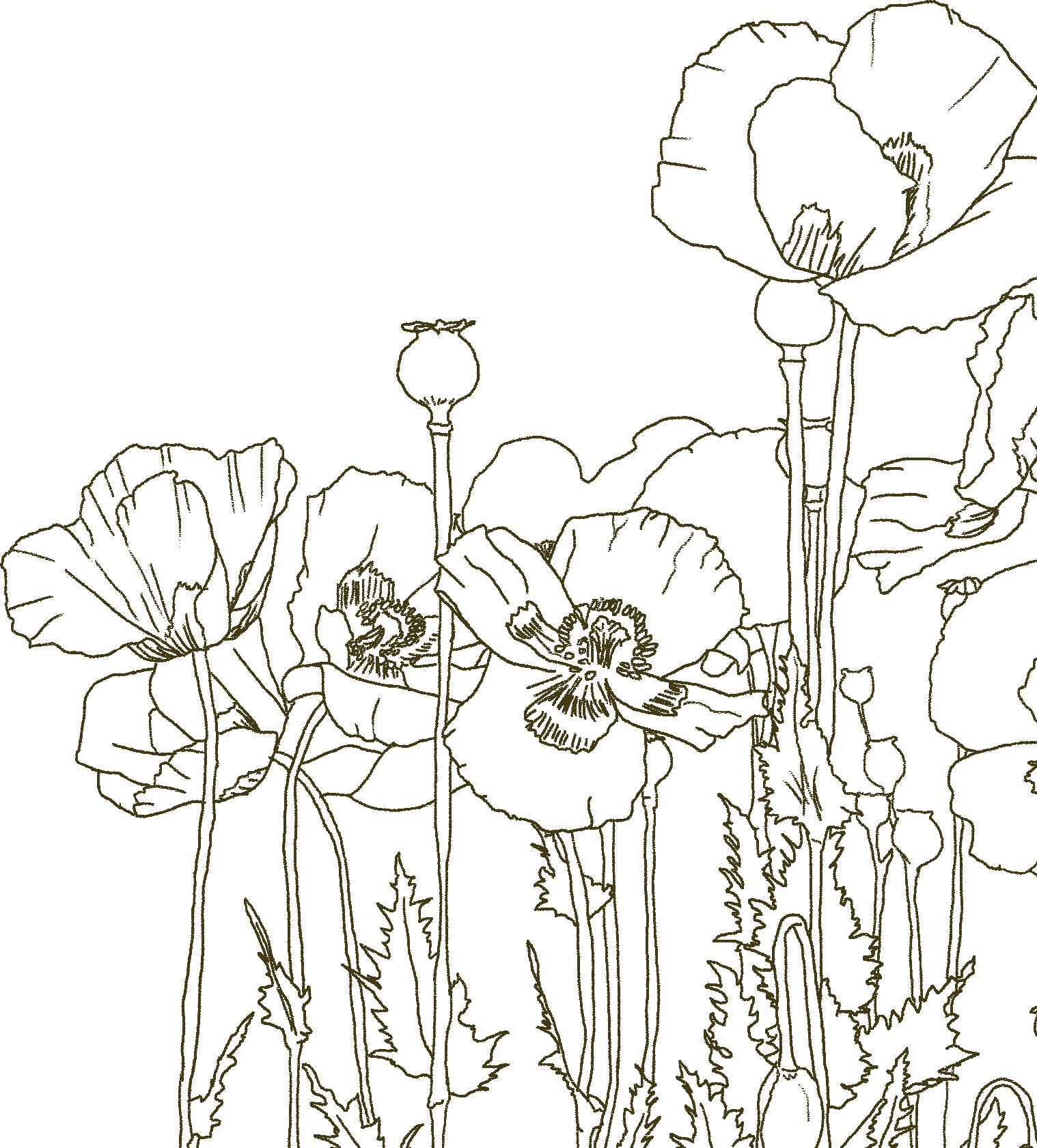
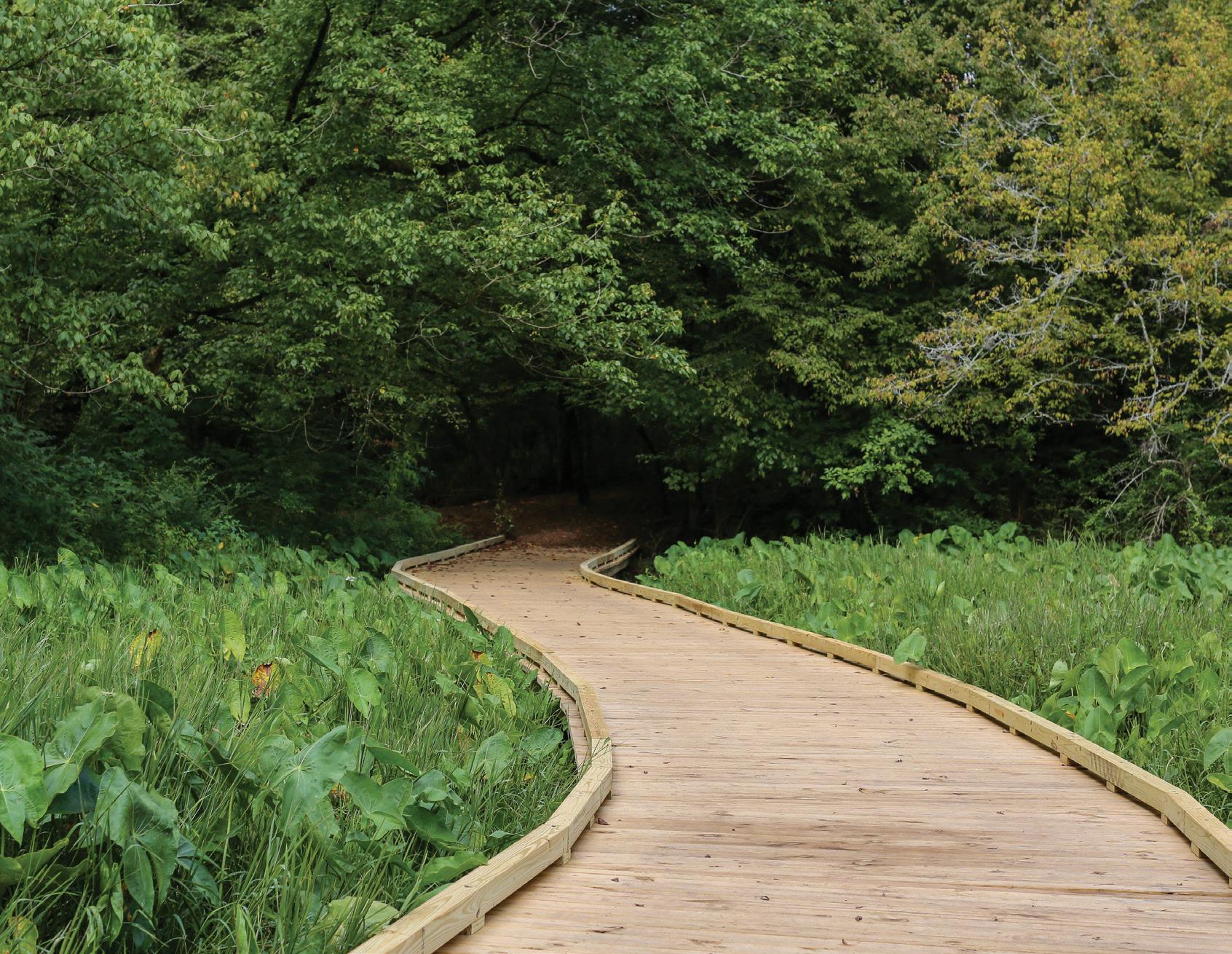
100,000+ 56,840
PLANTS PRODUCED FROM THE GREENHOUSE SPRING BULBS PLANTED 880+
SQUARE FEET OF ELEVATED TRAIL WALKWAYS ADDED
The horticulture and grounds department had a remarkable year, marked by exciting improvements to our trail system, growth within our garden spaces and preparations for impactful changes ahead.
Our department is responsible for the stewardship of all 323 acres of the State Botanical Garden of Georgia, including 30 acres of cultivated gardens and 7.6 miles of trails. With a team of 12 full-time staff and more than 20 part-time employees and student workers, we manage a living laboratory and plant museum that supports education and research for students, scholars and professionals. The garden is also a vital refuge for wellness, serving as a cherished space for the Athens community to enjoy daily hikes, peaceful exploration and connection with nature.
In 2024, we began installing elevated wooden walkways—called puncheons—to span low, wet sections of trails. Our initial puncheons, designed and installed by our grounds and trails team, helped test materials and design. Following this success, community partners, including Walmart volunteers and Eagle Scouts, helped build an additional 60 linear feet of puncheons—protecting both shoes and sensitive habitats.
We were honored to receive generous donations that transformed key areas of the garden, including funding from The Office of the Provost at the University of Georgia to help launch the Gateway to the Garden project.
Exciting projects lie ahead. With funding from the Vaughn-Jordan Foundation, we’re constructing a new trail as part of the Gateway to the Garden initiative. New bridges are planned for our trail system, and additional puncheons will be installed through upcoming Eagle Scout projects. Additionally, the entire trail system is undergoing a color and naming update to enhance wayfinding and simplify navigation for all visitors. The gardens continue to evolve as we refine and expand our botanical collections to enrich the visitor experience and support our educational mission.
- Jason Young, Director of Horticulture and Grounds
Garden historian Mac Griswold once said, “Gardening is the slowest of the performing arts.” Trees grow at a pace barely perceptible to the human eye, and gardens unfold over decades. While gardening is often slow and contemplative, it sometimes requires a bold, swift reset to clear the stage for something new.
One such refresh is now blooming above the Flower Garden, where the new Hillside Garden is taking shape as a tribute to Kathy Honey, given in her honor by her husband, William “Bill” Honey. In December 2024, the horticulture and grounds team planted 24,000 daffodil bulbs. Once the last bulb was tucked into the earth, 4 pounds of wildflower seed—California poppies (Eschscholzia californica) and red poppies (Papaver rhoeas)—were sown across the newly cleared soil.
The result: four continuous months of dazzling color spread across a half-acre where overgrown trees once stood. This spectacular bloom created a stunning new foreground for the Flower Garden vistas below—an ever-changing, living canvas that quickly captured the hearts of visitors.
After the spring bloom faded, the horticulture team removed the spent vegetation and began the next phase: installing droughttolerant American natives to stabilize the slope and continue the visual impact. Mexican sage (Salvia leucantha) and “White Cloud” muhly grass (Muhlenbergia capillaris) are now being planted to hold the soil and extend seasonal interest.
Once all the new plantings are in place, the cycle begins again. In early spring, the daffodils will return—lifting their sunny faces to the warming sun and signaling the start of another year of natural beauty. With its waves of color, ecological resilience and panoramic views, the Hillside Garden has already become a favorite among visitors—and promises to grow more spectacular each year. A slow and steady performance of nature, blooming brilliantly for all to enjoy.
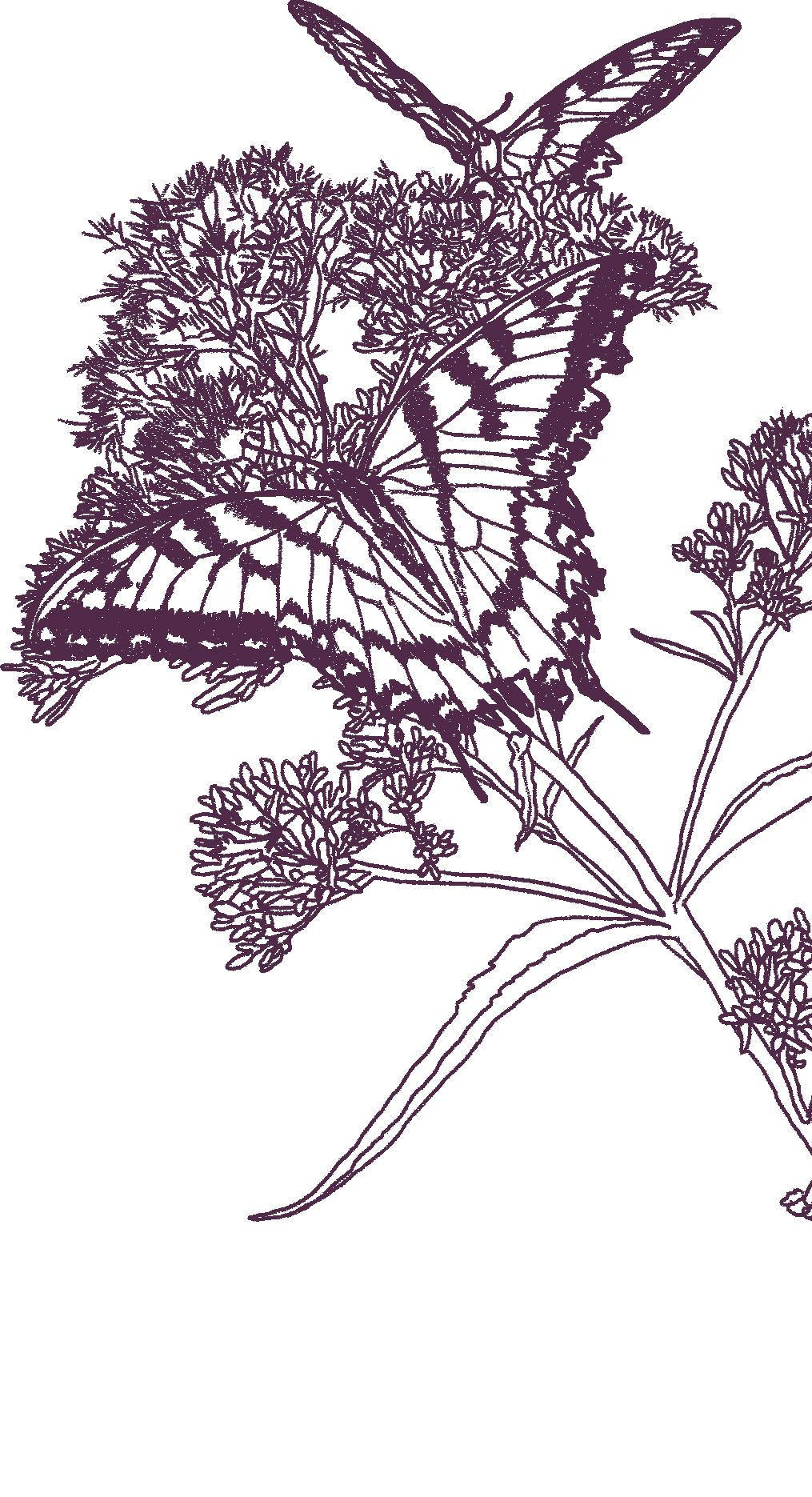


By: Laurel Clark, communications manager
A new accessible pathway in the Dunson Native Flora Garden at the State Botanical Garden of Georgia will allow more visitors to experience the beauty of the native plants and birds found within this section of the garden.
The new concrete path, made possible by the Riverview Foundation, replaces previous mulch paths, which were rustic, steep and narrow. The concrete path is 5 feet wide and ADA accessible, allowing barrier-free access to the garden.

“Dunson is a very special garden,” said the garden’s director of horticulture, Jason Young. “It is a unique representation of our natural areas, and providing ADA access to this garden gives visitors a chance to experience a beautiful forest in an accessible setting.”
The new pathway was constructed over where previous paths existed, and special care was taken to reduce the impacts on the existing plant life. The Dunson Garden is unique as it is set in a lower area of the State Botanical Garden, where soil accumulates due to water flow, creating a rich environment for plant
This garden includes many different species of trillium, native azaleas and spring ephemerals such as Virginia bluebells, bloodroots and trout
Parts of the new concrete path have wider sections, allowing space to linger and take in the surroundings. Young said the Dunson garden is a popular spot for birdwatching. The State Botanical Garden is an Audubon-designated important birding area.
“Our goal as the State Botanical Garden is to create an accessible environment for people of all ages to experience nature,” said Jenny Cruse-Sanders, director of the State Botanical Garden. “We are grateful to the Riverview Foundation for their support in expanding accessibility at the garden.”
The Riverview Foundation is a long-standing supporter of the State Botanical Garden and has funded other accessibility projects at the garden, including the wetland boardwalk and a concrete ADA-accessible pathway to the Middle Oconee River. The foundation supports habitat and wildlife conservation as well as parks and greenways.
“The Riverview Foundation is keenly interested in improving the connection of people to nature,” said the foundation’s executive director, Bruz Clark. “The State Botanical Garden has been the recipient of Riverview funding to establish the new ADA walkway, along with improvements to the Orange and White Trail, including the construction of the new wooden boardwalk along the banks of the Middle Oconee River.
“Both projects improve accessibility and exposure to the natural environment that are good for the mind, body and spirit.”




50
SEASON TICKETS SOLD TO SUNFLOWER CONCERT SERIES
1,030
SUNFLOWER CONCERT SERIES TICKETS SOLD
260+
$5,500+ REGISTRANTS TO 5 ORCHID MADNESS EVENTS
RAISED FROM ORCHID MADNESS TO SUPPORT THE HORTICULTURE DEPARTMENT
Events at the State Botanical Garden of Georgia are truly special, offering guests an opportunity to experience the garden in a new way and an exciting chance for community partners to engage with us. I currently manage two annual series that showcase different aspects of the garden for visitors to appreciate: Orchid Madness and the Sunflower Concert Series.

Each February, Orchid Madness celebrates the diversity of orchids from around the world. Organized to benefit the garden’s horticulture department, this event featured five experiences in 2025 that appealed to visitors of all ages. Guests enjoyed the elegance of Botanic Musicale, indulged in Condor Chocolates at Orchids and Chocolates, tapped into their creativity at Sip n’ Paint, deepened their knowledge at the Johnstone Lecture and gained hands-on experience at the Orchid Repotting Class. The events provided a unique opportunity to immerse oneself in the world of orchids while supporting the garden’s mission.
During the summer months, the Sunflower Concert Series created magical evenings in the Flower Garden. From June to September 2024, four live concerts brought music lovers together to enjoy picnics, blooms and great performances. Guests danced and relaxed to the sounds of The Original Splitz Band, The New Orleans Jazz Stompers, Abbey Road LIVE! and the Randall Bramblett Band. The concert series taps into Athens’ vibrant music scene, offering a unique way to experience performances beyond the traditional
Whether you’re interested in a quiet evening learning about orchids or tapping your feet to live music amongst the flowers, I hope you join us for more memorable events this year!
- Kimberly Futrell, Major Events Manager

10,000+ MUSEUM VISITORS
VISITORS FROM STATES AND COUNTRIES
49 34
1,400+ AUGUST 2024 WAS THE BUSIEST MONTH WITH VISITORS
Over the past year, with the help of garden staff and a dedicated volunteer corps, I have watched the Porcelain and Decorative Arts Museum grow busier and more integrated into the culture of the State Botanical Garden. It has been my pleasure to witness this growth through increased tours, programs and volume of visitors. Over the past year, the museum has given 14 tours to UGA-affiliated and Athens-area groups. As the museum continues to gain recognition for its world-class collection, I am confident that those numbers will continue to rise. We welcomed guests from Georgia Women Give in November, educated nearly 100 guests for the Deen Day Sanders Lecture in April, and participated in February’s Friends First Friday with a lecture on Dorothy Doughty, among other things.
The previous year has also seen an increase in visitor engagement at the museum. We have designed gallery scavenger hunts that are always available and have been extremely successful in encouraging people of all ages to slow down and engage closely with art. With the support of UGA Public Service and Outreach (PSO) and the Learning by Leading team at the garden, the museum supported a PSO Student Scholar intern, who researched and designed a selfguided tour brochure complete with information about the museum and its collections. The brochure directly supports the garden’s mission to teach and educate and has become an exciting addition to the museum experience.
Over the past year, we have witnessed significant growth at the Porcelain and Decorative Arts Museum. On behalf of myself and the museum, I would like to thank all those who have supported us through visits, tours, programs and other engagements. With great excitement, I look forward to the upcoming year.
-
Grace Moorman, Porcelain and Decorative Arts Museum Curator


49 29
VISITORS FROM STATES AND COUNTRIES
65,000
WINTER WONDERLIGHTS VISITORS
134,000
VISITOR CENTER GUESTS
10,000+ MUSEUM VISITORS
It was a very successful year of growth at the State Botanical Garden of Georgia for the Visitor Services team. The Visitor Center staff welcomed over 465,000 visitors to the garden, representing a 23% increase from the previous fiscal year. An estimated 134,000 visitors were welcomed in the Visitor Center, and over 10,000 visited the Porcelain and Decorative Arts Museum. Guests visited from 49 of the 50 U.S. states, plus Puerto Rico, and 29 different countries. Visitors also represented 127 of the 159 counties in Georgia.
Visitor Services supports the garden’s operations with the gift shop and eight rental venues. In this fiscal year, the garden hosted 90 weddings and 13 walk-up weddings. Other rentals at the garden included retreats, meetings, classes and workshops. With an increase in visitors to the garden, the gift shop was able to boost overall sales by 85% compared to the previous year. This increased revenue enabled a gift shop remodel that expanded display and merchandising space.
The garden relies heavily on the kindness and hard work of a roster of over 350 volunteers. In this past fiscal year, volunteers contributed over 15,000 hours of their time to the garden. Over 63 active volunteers worked at least two shifts a month, supporting several garden areas. This included assisting curators in the garden, helping customers in the gift shop and welcoming visitors in the Museum and Visitor Center.
Garden tours have been an important and educational way for visitors to experience the garden. This year, there were 71 tours with 647 guests. The team expanded the opportunity for garden tours by making affordable walk-up tours available every Tuesday through Friday.
Thank you to everyone who visited the garden, went on a tour, experienced Winter WonderLights or volunteered with us. We’re excited to welcome even more visitors to the garden this year!
- Daun Fest, Associate Director for Administration and Visitor Services

The 2024 Winter WonderLights was our most successful season yet, and Visitor Services played a vital role in that achievement. From daily operations to enhancing guest experiences, our team helped bring the magic of the garden to life in over 30 unforgettable nights.
One of the biggest highlights of the season was the overwhelming success of our s’mores stations. Nearly 9,000 s’mores were sold, making it one of the most popular and memorable features of the event. Families gathered around fire pits to roast marshmallows, creating lasting memories and adding a warm, festive atmosphere to the show.
Our Managers on Duty ensured seamless coordination at check-in, maintained smooth guest flow and handled nightly operations with professionalism and care. Their presence was a key factor in our ability to efficiently respond to guest needs and maintain a high level of service throughout the show.







